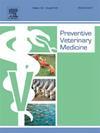猪繁殖与呼吸综合征病毒在乌干达西部小农养猪场的传播
IF 2.2
2区 农林科学
Q1 VETERINARY SCIENCES
引用次数: 0
摘要
生猪生产在乌干达是一个快速增长的部门,特别是在小农中,它为他们提供了重要的收入来源。然而,猪繁殖与呼吸综合征(PRRS)等限制生产力的疾病带来的负担是一个重大挑战。由于缺乏关于这些病原体在国内发生的信息,这种情况更加严重,突出表明需要研究其传播动态以进行有效控制。在这里,我们模拟了PRRS在乌干达西部的传播,并评估了其在旨在弥补与设备共享、自由放养、公猪共享、农场访问和重新放养等做法相关的生物安全差距的战略下的控制情况。我们使用来自398个养猪户的数据来评估养殖实践,并估计接触率和距离,以模拟研究区44125个猪场中PRRS的传播。发现该地区养猪场的生物安全措施较低,只有0.8 %的养猪场全年将整个猪群关起来,限制未经授权的人员进入,并使用消毒剂。在目前的生物安全状况下,PRRS爆发将导致17年的死亡。57 该地区两年内有57%的猪场受到感染,其中中型和大型小农养殖场受影响最大。疫情将持续2年以上(可能性为67.80 %),在引入后700天左右稳定下来;患病率达到5.15 %;在流行阶段,平均每天有17个农场受到感染。然而,消除游客流量可以完全阻止PRRS的传播,而消除与野猪共享、重新放养和清除相关的风险将分别导致99.85 %、99.44 %和40.67 %的减少。此外,即使适度采取与农场访问或猪共享有关的改进的生物安全措施,也可以显著减少PRRS在该地区的影响。例如,在所有猪场减少25 %的农场访问频率或猪共享,可以分别减少99.61 %或73.95 %的PRRS传播。这一结果也可以通过在大型小农农场实现50% %的目标采用率,以及在中型农场实现25% %的目标采用率来实现。鉴于诸如PRRS等限制生产力的疾病对乌干达快速增长的养猪业构成的挑战,我们的研究结果强调了在小型养猪场促进加强农场生物安全措施的必要性。本文章由计算机程序翻译,如有差异,请以英文原文为准。
Porcine Reproductive and Respiratory Syndrome Virus transmission among smallholder pig farms in western Uganda
Pig production is a rapidly growing sector in Uganda, especially among smallholder farmers to whom it provides a vital source of income. However, the burden of productivity-limiting diseases such as Porcine Reproductive and Respiratory Syndrome (PRRS) poses a significant challenge. This is exacerbated by the paucity of information on the occurrence of these pathogens within the country, highlighting the need to study their transmission dynamics for effective control. Here, we modelled the transmission of PRRS in western Uganda and evaluated its control under strategies targeting closure of biosecurity gaps related to practices such as equipment sharing, free ranging, boar sharing, farm visits, and restocking. We used data from 398 pig-farming households to assess husbandry practices, and to estimate contact rates and distances for simulating the spread of PRRS among the 44,125 farms in the study area. Biosecurity measures were found to be low among pig farms in the region, with only 0.8 % of them keeping their entire herd confined all-year round, limiting access to unauthorized persons, and using disinfectants. Under the current state of biosecurity, a PRRS outbreak would result in 17. 57 % of the pig farms in the region being infected within two years, with the medium and large-scale smallholder farms being most affected. The outbreak would persist beyond 2 years (with a 67.80 % likelihood), stabilizing around 700 days post-introduction; reaching a prevalence of 5.15 %; and with a median of 17 farms being infected daily during this endemic phase. However, eliminating visitor traffic could entirely halt PRRS spread, while eliminating risks associated with boar sharing, restocking, and scavenging would lead to reductions of 99.85 %, 99.44 %, and 40.67 %, respectively. Furthermore, even a moderate adoption of improved biosecurity measures related to farm visits or boar sharing, could significantly reduce the effects of PRRS in the region. For instance, reducing the frequency of farm visits or boar sharing by 25 % across all pig farms could reduce PRRS transmission by 99.61 % or 73.95 % respectively. This outcome could also be achieved through a targeted adoption rate of 50 % within large-scale smallholder farms coupled with a 25 % rate for medium-scaled ones. Our results highlight the necessity of promoting enhanced on-farm biosecurity practices in smallholder pig farms, given the challenges posed by productivity-limiting diseases such as PRRS, in Uganda’s rapidly growing piggery industry.
求助全文
通过发布文献求助,成功后即可免费获取论文全文。
去求助
来源期刊

Preventive veterinary medicine
农林科学-兽医学
CiteScore
5.60
自引率
7.70%
发文量
184
审稿时长
3 months
期刊介绍:
Preventive Veterinary Medicine is one of the leading international resources for scientific reports on animal health programs and preventive veterinary medicine. The journal follows the guidelines for standardizing and strengthening the reporting of biomedical research which are available from the CONSORT, MOOSE, PRISMA, REFLECT, STARD, and STROBE statements. The journal focuses on:
Epidemiology of health events relevant to domestic and wild animals;
Economic impacts of epidemic and endemic animal and zoonotic diseases;
Latest methods and approaches in veterinary epidemiology;
Disease and infection control or eradication measures;
The "One Health" concept and the relationships between veterinary medicine, human health, animal-production systems, and the environment;
Development of new techniques in surveillance systems and diagnosis;
Evaluation and control of diseases in animal populations.
 求助内容:
求助内容: 应助结果提醒方式:
应助结果提醒方式:


